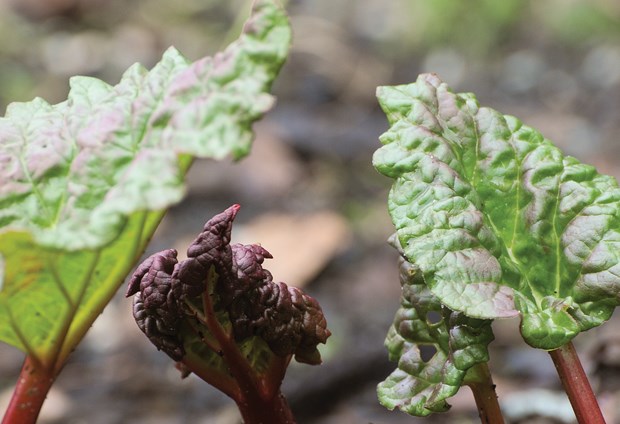I am always grateful for February's few bright sunny days.
They motivate me to get into the garden to look at how things are doing, which serves as a great reminder of all the early spring tasks I've procrastinated doing in the pouring rain. For the last few years our springs have come earlier than usual on the West Coast (2015 was a record breaker!), and it seems the same is true this year. In my garden, our daffodils are out, the fruit trees' buds are swelling, and the chard, rhubarb and kale are sporting bright new leaves.
Every year I like to add a few more perennial edible plants to my garden, and early spring is a great time to plant new ones, prune, or tend to these perennials. Rhubarb, blueberries, raspberries, and plum trees are some of my favourites, and you can find varieties that do well in pots for a balcony garden too.
As usual, I'm late pruning the fruit trees; if you find yourself in the same position try to get them pruned as early as possible this month. It's best to do spring pruning while the trees are dormant (before the buds begin to swell). This early spring pruning is important to remove dead or diseased branches, but it also invigorates your tree as its resources are directed to the remaining buds to produce vigorous spring growth. If you haven't pruned a fruit tree before, consider attending a workshop or hiring a local arborist to ensure you maximize fruit production and keep your trees healthy.
My rhubarb patch started with a couple of small crowns from a friend who was dividing her large old plants. With diligent dividing every couple of years, we've created a small forest of rhubarb - yum! I know it's time to divide my rhubarb when the buds begin to uncurl and mini stalks are visible. Some people divide their rhubarb while it's totally dormant, but I use these first shoots to help guide where I cut the crown. Gently dig your rhubarb out and keep as much of the root mass intact as possible. Good aim, and the clean blade of a spade make quick work to split the crown into four to eight pieces. Each piece should have about a five centimetre cross-section of root and a bud. Replant immediately with some fresh compost, and avoid harvesting this year while the new crowns build up their energy reserves.
My focus switches to the annual vegetable patch once I've finished pruning, dividing, and planting my edible perennials. Technically speaking, a lot of the gardening I do in March could be skipped or put off until later in the season. However, getting into the garden in March always feels great after a long winter and it means that I will be harvesting much earlier too. I begin with preparing our soil for planting. Due to our mild winter a lot of weeds over-wintered well in my veggie patch, and are already growing strong.
Weeding, digging in compost, and fluffing your soil about two weeks before transplanting your seedlings will help get your garden off to a good start. The first seedlings transplanted in March are hardy varieties of kale, chard, lettuce, arugula and spinach. Harden off your seedlings very well before transplanting to ensure all your hard work raising them is not wasted. Keep weed pressure down by regularly cultivating the top three cm of soil with a hoe. This preventative task will uproot baby weeds, prevent them from taking hold, and save you hours of weeding down the road.
St. Patrick's Day is potatoplanting day in my books! Place your seed potatoes on a bright cool windowsill to encourage them to develop sturdy little buds about a week before you plant. This will kickstart your potatoes' growth and ensure an abundant and early crop. For early season varieties, like Warba, it is a good idea to select the four strongest buds on each seed potato, and rub off all the others. Seed potatoes should be the size of a large ice cube; plant them whole or cut them to this size with at least one bud per piece.
There is a lot to do in the garden in March - enjoy!
Emily Jubenvill grew up on the North Shore and is passionate about growing fresh organic food. When she's not in the garden you'll find her on a mountain or by the sea. She's the manager of the North Shore Neighbourhood House's Edible Garden Project, and you can reach her at [email protected] or ediblegardenproject.com.



